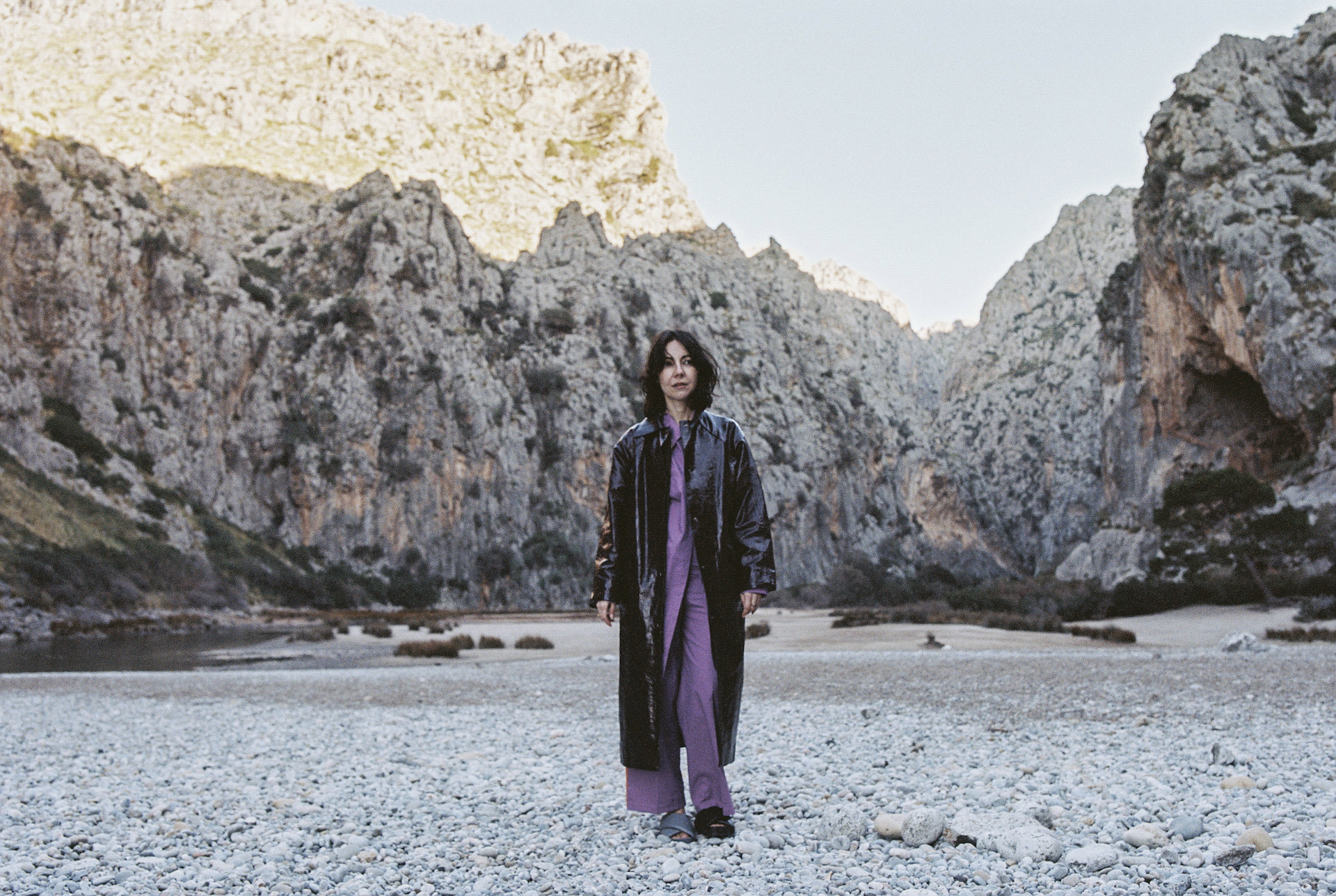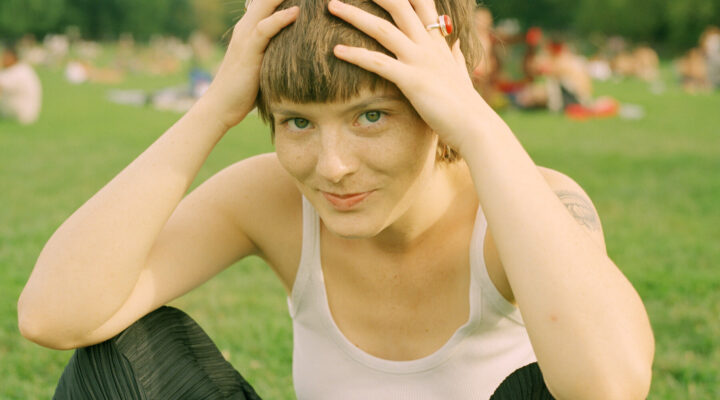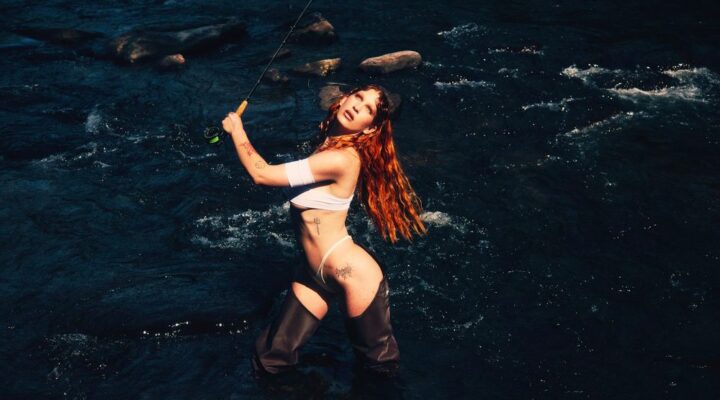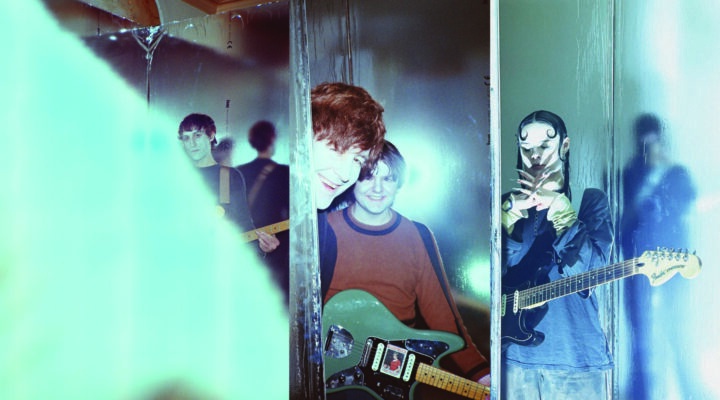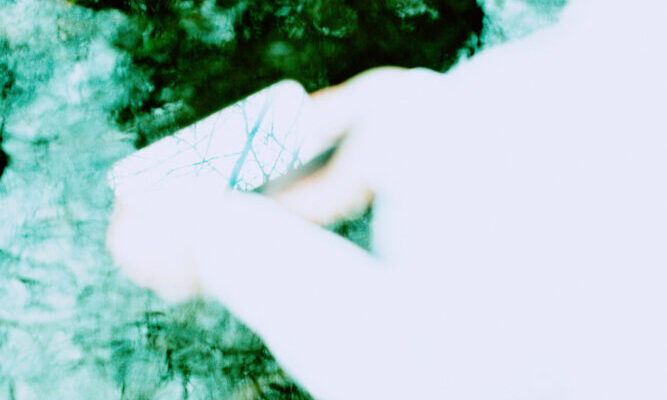An Interview with Lucrecia Dalt
by Sydney van Nieuwaal
Photos by Aina Climent
Photo in Oude Kerk by Maarten Nauw
At the outset of summer, Subbacultcha collaborated with Oude Kerk and invited Lucrecia Dalt for Silence #37 – a versatile artist, whose sonics settle and unsettle, intoxicate and shake awake. The electroacoustic artist “thickens the air with sounds that swing and dangle, illuminated by the radiance of her voice and ripples of percussion.” While Lucrecia was packing up her instruments after a space-disorienting morning concert in the monumental church, I chatted with her about gear, glossolalia and sci-fi storytelling. Over the course of summertime, that conversation was continued over a Zoom call. Read the documentation of the latter here, looking back, inward and ahead.

Hi Lucrecia! It’s been a while.
I know!
It might feel a bit odd going into some of these questions about reflecting.
Well, it feels like a transitional moment anyway.
Alright. Let us start looking back. We met at your performance for the concert series, Silence, in the Oude Kerk. That series usually starts in complete silence. Attendees start the morning in a near absence of sound and wait for the first impulse. What immediately struck me that morning in June, was that we were greeted by a loop of pads upon entering the church. What were your thoughts behind this?
I guess many. I always end up thinking about other dimensions and things like that. Or of a frozen moment. It felt like a frozen loop, one that was rather difficult to locate. I mean, you knew where it came from, but it wasn’t invading you. It was about making the space feel a bit different than you might be used to. Also, because of the time of the concert, I wanted to start off with a certain mood.
The concert took place from eight until nine in the morning. How did you take that into account in your performance?
I mean, I’d never done anything like that before! So, I could only live it in the moment. The night before I could barely sleep, and I was in some sort of state of delusion or something. And then, arriving at the church so early, it becomes quite a bizarre experience.
One moment that stood out to me was when the concert ended at nine, the church bells started ringing, but simultaneously, birds started chirping.
Well, I was sending those bird sounds through a very directional speaker, bouncing them off the ceiling!
I thought I heard that, plus birds from outside!
No, this is a really powerful speaker! When directing it upwards it really sounds like a flock of birds on the ceiling.
I see. Speaking of spatial elements; you told me that you positioned a guitar amplifier at the pipe organ – tens of meters away from where you performed. Also you strolled through the church, generating sounds along the walk. Can you tell me a bit more about how you approached the space of Oude Kerk?
Well, I was thinking about how I could effectively play with the space, be it in a very subtle way. I wanted to have an element far away from me to create an impulse-response dialogue between the church and myself. And, I like guitar amps for their crunchy and warm sounds. We played it quite loud, helping it bounce through the wood.
How does it feel playing so “vastly”?
It feels beautiful! I love that experience. I’m not a huge fan of reverb and I have a lot of difficulties with it. But this case was one of the first times where I feel like I could embrace it and make it part of the show. With regards to the walking: I placed a microphone with a resonator in my shoe, and the wonderful technician worked with me in finding the two notes that resonated the most. So, we played with that in a way that the sound starts feedbacking. But at that moment, the technician would bring it down a little for it not to start droning. We emphasized on certain frequencies that resonated with the space. In doing that, and moving my feet like I was facing the speaker, I had control over taking in the sound to the point of feedback, and then bringing it back down. It was really fun and very simple.
Aesthetically, it worked very beautifully as well, strolling through the church halls.
I think the space was gorgeous. You could feel the sound everywhere.
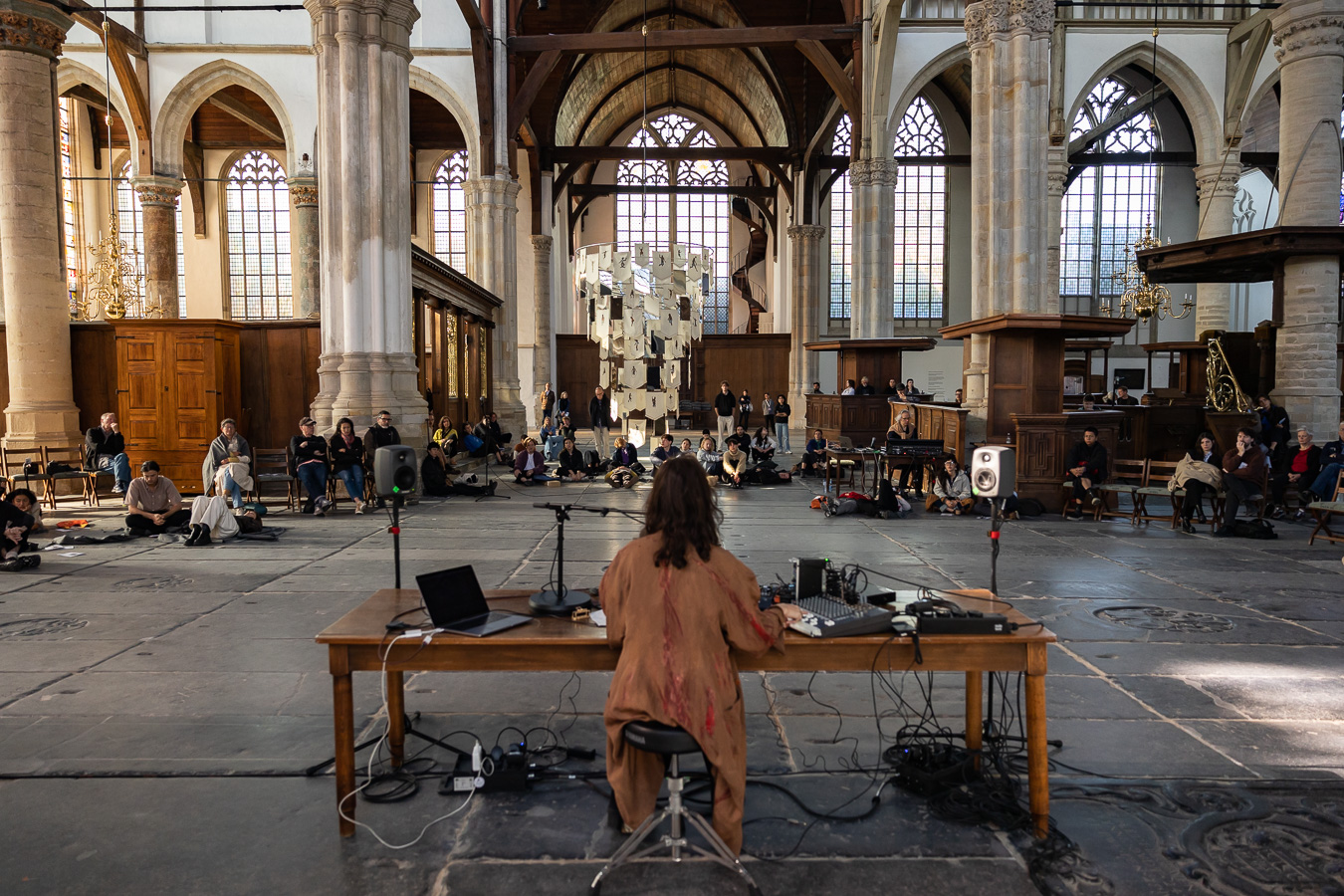
During your performance and on your album No Era Sólida, you use your voice. However, it seems that often you do so wordless. Is that correct?
Exactly. The first song of No Era Sólida was complete improvisation. I would listen to singers in languages I don’t know for hours. I would kind of like to get my brain into a zone and start improvising. A way to reprogram the way I would react naturally.
On No Era Sólida we follow this character, named Lia. Throughout the music, Lia communicates in tongues, wrestling with a spell laid on her speech. That is, until the spell is broken, and Lia speaks freely. She asks: “Can paralysis transform a person into a thing?” What experiences or thoughts laid the foundation to this question?
That is a question asked in a book by Clarice Lispector, which I grabbed as a starting point. The character, Lia, is heavily inspired by a character in that book. Also, I was reading Gloria Anzaldúa’s Borderlands, La Frontera. In that book, there’s a dialogue with an entity. I thought: I’m going to imagine that there is a sort of entity in my studio that is kind of collaborating with me. I’m going to pretend that I will perform from that subjectivity, which is a little more devoid of all the ethical questions I have in my head. To let it all be valid, or something like that. To let it be more intuitive. Also, part of this was initiated at a performance I did at the Ludwig Mies van der Rohe pavilion in Barcelona. I was writing a piece for the sculpture that is there. She’s shaped as a human, but very androgynous. I was thinking about how it is to be her. You know, how is it to be in that building where you have people coming in every day to look at you? And, she’s made of marble, which is older than human anyways. From thereon she starts to question “the human”. I grabbed some things from there for the character as well.
When channeling this subjectivity: how do you position yourself while playing? In other words: how aware or conscious are you about what you are doing? Are you in full-micro-detail-focus or do you let intuition flow freely?
It depends from concert to concert. But, because of this question I realize that apart from sleeping, that is probably the place in which I am the least aware of my body. I am just pure conduit, or something like that. I try to let the pieces flow through, use my ears and tune in with the space. But, this peculiar state had to grow on me over time. Initially I had to be very focused on the machines, but as you perform more and more you start to have this sort of endosymbiosis with them. It becomes a part of you and you can become the conduit. When that happens, performing becomes pure joy.
That sounds wonderful. Perhaps it is a bit too early to tell, but your latest records have been rather loose in form and song-structure. With your upcoming album, ¡Ay!, songs are shaped a bit more linearly. How do you see this conduit role exist within a more tight structure?
Yes, I don’t know… This is what I am trying to figure out right now. I’m not sure if I will be able to achieve that state very quickly. It is a whole new way of performing. I will be singing in a way I haven’t done in a long time, and I’ll be on stage with a percussionist. So, I will also have to be aware of the other. But, I don’t follow a total linear structure. I will stay in certain fractions for a while, and jump onto the next stuff when ready. I hope that at some point it will become so fluid that it feels like that state, but also honor the structures of the songs. That would be ideal for me.
Exciting to see where it will take you!
Totally.
You mentioned to me how the themes of your music are often characterized by science-fiction. What about this genre of fiction is interesting to you?
I mean, there are many forms in science fiction. I guess the type I like is the one working with classic questions about our finitude and limitations as humans. Where the science-fiction elements aren’t too explicit. Also, I don’t have the budget for special effects and stuff like that, haha. When you see my latest music videos, and you don’t know anything about the story, you just feel like you’re watching friends hanging in Mallorca. Just like The Man Who Fell To Earth, with David Bowie, by Nicolas Roeg. It’s very much sci-fi, yet not so straightforward.
Can you tell something about the story?
So, when creating ¡Ay!, I was discussing a lot of these ideas with the philosopher Miguel Prado. He’s a friend and I invited him to help me write a script. We were exchanging movies, documents and ideas, and at some point I had the image of all these particles of human skin, entering in the cycle of water. So we imagined a sci-fi world where there was a market up in the hydrosphere for human skin, for other consciousnesses to purchase and experience. That was the origin; the premise. From there we imagined a consciousness, Preta. We asked ourselves whether she has a mission. How does he use her newly bought body? What are things she feels for the first time? The record basically goes around all these different experiences, from her point of view and from the point of view of people who see this bizarre lady licking rocks and doing all this stuff, haha. And, her mission is to create an anomaly on earth so humans can experience “no time”, which is her permanent state. So, we got really deep into that. It goes to some, I don’t know, fun places.
The lyrics of this album are full of references to geology. Of which my favorite is in the song ‘El Galatzó’, where you, or Preta, surprise the receptor with the news you have “felsic spring powers”. This isn’t the first time that rocks and minerals have appeared in your work. Also, you have a background as a geotechnical engineer. How does geology find its way in your music?
I guess! I mean, it all started because I studied civil engineering. I was working as a geotechnical engineer in teams on all matters related to soil. Like: why and how can you build on top of that? After I quit I was puzzled about what I could do with all the information I learned, as it was such a big dedication. I needed to find a way to introduce it somewhere else. I guess initially I did, just metaphorically, to speak about time and love. It slowly started to become more present in my work. In the most present case, very much so, as when Preta comes to earth, the only thing she can relate to are rocks. That is, because it’s the only timeless object she shees. Time exists only in its surroundings. There she realizes that rocks are the perfect space to create these anomalies.
Throughout the lyrics of ¡Ay! I read a lot about transitory forms, being stuck in structures, technical and social, and walking into the limitations thereof. Am I reading it correctly that ¡Ay! is also very much about structure versus structureless?
I don’t know. I wanted to make an album in which I would put together everything I liked and cared about. This is the first time I really had the time to do that. You know, to meditate on things. Musically, it took me a while to really arrive at the point at which I felt what I was doing was creating the effect I was intuitively imagining. I didn’t want to replicate genres I listened to when growing up, but I wanted to bring the diluted memory of those rhythms. It was a big study to sit down and start from, Bolero patterns for example, and see how we could shift it a little bit so that it feels different but keep traditional elements within there as well.
Most of all, I sense a lot of references and explorations of liminality and (a)temporality on the album. Preta’s timelessness makes me wonder if to you this is a reflection on our human absorption with time?
That’s basically one of the first things that she noticed when arriving on earth, our obsession with time. She is really worried about that, haha! So, yes, it is.
Is Preta going to bump into the limitations of time?
You will discover in the next video!

Lucrecia Dalt’s ¡Ay! will be released on the 14th of October, on RVNG Intl. Find more info here.
